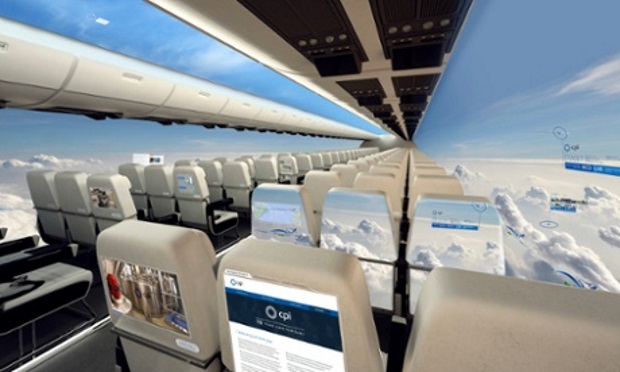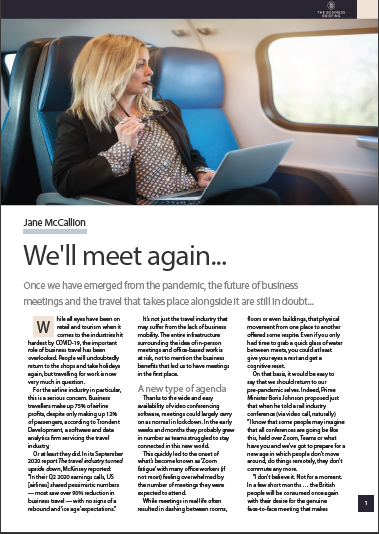Energy-saving windowless plane being developed
UK developers are working on an energy-saving plane with smartscreen panels instead of windows


The windows on commercial planes could be replaced with smartscreen panels within 10 years, a group of UK developers have promised, after early concepts for a windowless plane have surfaced.
The panels, situated on the back of seats and as the walls of the plane, can be turned on and off according to preference. They could be used by passengers for a range of activities such as viewing the outside sky, checking emails and browsing the internet during their journey, The Guardian reports.
Dr Jon Helliwell said: "You could have a display next to a seat if you wanted it; you could have a blank area next to a seat if you wanted it; you would have complete flexibility as to where you put [the panel screens]. You could put screens on the back of seats in the middle and link them to the same cameras."
The technology is being developed by the Centre for Process Innovation in north-east England, and its primary goal is to scale down the weight of commercial aircrafts and subsequently save energy.
The inclusion of windows on an aircraft requires walls to be further reinforced, so without them the plane would be far lighter.
"We had been speaking to people in aerospace and we understood that there was this need to take weight out of aircraft," Helliwell continued.
"Follow the logical thought through. Let's take all the windows out that's what they do in cargo aircraft what are the passengers going to do? If you think about it, it's only really the people that are sitting next to windows that will suffer."
Get the ITPro daily newsletter
Sign up today and you will receive a free copy of our Future Focus 2025 report - the leading guidance on AI, cybersecurity and other IT challenges as per 700+ senior executives
The concept would be possible with flexible organic light-emitting diodes (OLEDs), which eliminate the need to encase the lights in inflexible glass casings and make them suitable for use in aeroplanes. It is the same technology used in mobile phones and TVs.
Problems with cost and durability still stand in the way of making it a reality just yet, however.
"What would be great would be to make devices based on OLEDs that are flexible," Helliwell added.
"We can make transistors that are flexible but if we can make OLEDs that are flexible, that gives us a lot of potential in the market because we can print OLEDs on to packaging, we can create flexible displays."
Caroline has been writing about technology for more than a decade, switching between consumer smart home news and reviews and in-depth B2B industry coverage. In addition to her work for IT Pro and Cloud Pro, she has contributed to a number of titles including Expert Reviews, TechRadar, The Week and many more. She is currently the smart home editor across Future Publishing's homes titles.
You can get in touch with Caroline via email at caroline.preece@futurenet.com.
-
 Should AI PCs be part of your next hardware refresh?
Should AI PCs be part of your next hardware refresh?AI PCs are fast becoming a business staple and a surefire way to future-proof your business
By Bobby Hellard
-
 Westcon-Comstor and Vectra AI launch brace of new channel initiatives
Westcon-Comstor and Vectra AI launch brace of new channel initiativesNews Westcon-Comstor and Vectra AI have announced the launch of two new channel growth initiatives focused on the managed security service provider (MSSP) space and AWS Marketplace.
By Daniel Todd
-
 ZINFI updates PRM platform to meet hybrid workforces’ needs
ZINFI updates PRM platform to meet hybrid workforces’ needsNews New features connect widely dispersed, multilingual business teams
By Praharsha Anand
-
 We'll meet again: The future of business meetings and travel are still in doubt
We'll meet again: The future of business meetings and travel are still in doubtWhitepapers Sample our exclusive Business Briefing content
By ITPro
-
 The IT Pro Podcast: Transforming air travel in a crisis
The IT Pro Podcast: Transforming air travel in a crisisIT Pro Podcast How the airline industry is using the pandemic to transform its IT
By IT Pro
-
 Up in the air: Travel in the age of COVID-19
Up in the air: Travel in the age of COVID-19Whitepapers Sample our exclusive Business Briefing content
By ITPro
-
 How to manage your work/life balance when away on business
How to manage your work/life balance when away on businessIn-depth Nothing messes with 'you time' more than business travel, but here are a few things you can do to maintain your work/life balance
By Bobby Hellard
-
 Airport check-in delays caused by 'network issue'
Airport check-in delays caused by 'network issue'News Spanish software giant Amadeus's outage plagues airlines around the world
By Joe Curtis
-
 Cisco wants to put superfast Wi-Fi on trains
Cisco wants to put superfast Wi-Fi on trainsNews ScotRail will trial 300Mbps on-board internet until March 2018
By Clare Hopping
-
 Delta CEO apologises to customers following systems meltdown
Delta CEO apologises to customers following systems meltdownNews A power outage was to blame for flight cancellations
By Joe Curtis